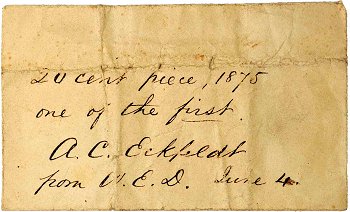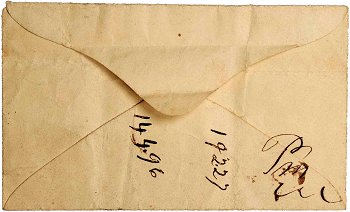This story even found its way into the Annual Report of the Director of the Mint for the fiscal year ending June 30, 1874.
|
A bill authorizing the coinage of a twenty-cent silver piece passed the Senate at the last session of Congress, but was not considered in the House of Representatives for want of time. The issue of a coin of that denomination will not only be in accordance with our decimal system of money, but will remove a difficulty in making change which now exists upon the Pacific coast and in Texas, where the five-cent copper-nickel coins do not circulate, and where it was formerly the practice to apply the term “bits,” “two bits,” and “four bits,” respectively, to the fractions of the Spanish dollar which circulated there. The custom appears to continue, notwithstanding those coins have disappeared from circulation. Accordingly, if a payment of one bit is to be made, and a twenty-five cent coin be used for the purpose, a ten-cent coin (one bit) is returned as the proper change, five cents being lost in the transaction by the purchaser. The issue of a twenty-cent coin will no doubt remove this difficulty. It may be added that, although this “bit” system appears to be quite an unimportant matter, few visitors to the Pacific coast fail to suffer some vexation at least from its existence. Inquiry is occasionally made as to why the coinage of the silver five-cent piece was discontinued. The reason appears to have been that it would, on the resumption of specie payments, be likely to expel from circulation and drive into the Treasury for redemption the five-cent copper-nickel coins. At first glance this may appear improbable, but when it is considered that the original law authorizing the issue of copper-nickel five-cent coin provided for its redemption in lawful money of the United States, it will be seen that there must come a time when it will be superior to the five-cent silver coin, and for the reason that it will be exchangeable for notes redeemable in gold coin. The silver coin, which would have a greater nominal than intrinsic value, and not redeemable in lawful money, or gold coin, would become the inferior currency. The five-cent copper-nickel coin having been issued to the extent of over $5,000,000, and the amount being sufficient for a token coin of that denomination, the provision of law discontinuing the issue of the five-cent silver coin appears to have been proper. |
Although Senator Jones’ story supporting the genesis of the denomination is quite charming, there appears to be little or no credible independent evidence that such a vexing circumstance
actually existed for customers and merchants in the West. Perhaps Senator Jones was once short-changed himself, heard anecdotes of such occurrences from his constituency, or just needed
a memorable story to convince others of the need for his new coin. Regardless, if solutions to this short-changing problem were needed, there were far more simple ways to address the
issue than creating a new denomination. An obvious solution would be to produce more dimes. And in fact, vastly more dimes would be produced in 1875 and 1876 as compared with prior years.
Another obvious solution would be to produce more five-cent pieces. This solution, however, would not be ideal as those in the West greatly preferred silver coinage over minor coins made
of copper and nickel. Regardless of the story’s validity, the new denomination was approved on March 3, 1875.
The records of the Congress are replete with lengthy and animated discussions about issues of national importance to debates over what could be considered trivial. Some of these intense
discussions were about coinage, especially when new coins are discussed. Given the subsequent failure and distain from the public of the denomination, it is ironic that no discussions
regarding the issue of the new denomination were found in the congressional record of the 1870’s. In fact, the first mention of the coin was on March 3, 1875 when Michigan
Representative George Willard asked for unanimous consent to have the bill passed that authorizing the coin. Remarkably, President Grant signed the bill the same day. The only discourse
that occurred at the reading was from New York Representative Clinton L. Merriam who waived objection to the bill since he understood that the coin was being minted for use only in the
Pacific states. Such did not end up being the case, of course. The passage below is from the second session of the Forty-third Congress.
|
Mr. WILLARD, of Michigan. I ask unanimous consent to have passed at this time a bill reported favorably by the Committee on Coinage, Weights, and Measures. It is a bill (S. No. 468) authorizing the coinage of a twenty-cent piece of silver at the mints of the United States. The bill was read. It provided that there shall be, from time to time, coined at the mints of the United States, conformably in all respects to the coinage act of 1873, a coin of silver of the denomination of twenty cents and of the weight of five grams; the twenty-cent piece shall be a legal tender at its nominal value for any amount not exceeding five dollars in any one payment; that in adjusting the weight of the twenty-cent piece, the deviation of the standard weight shall not exceed one and one-half grains; and in wieghing a large number of pieces together, when delivered by the coineer to the superintendent, and by the superintendent to the depositor, the deviation from the standard weight shall not exceed two-hundredths of an ounce in one thousand pieces; that all laws now in force in relation to the coins of the United States and the coining of the same shall, as far as applicable, have full force and effect in relation to the coin herein authorized, whether those laws are penal or otherwise, and whether they are for preventing counterfeiting or abasement, for protecting the currency, for regulating the process of coining and the preparation therefor, or for the security of the coin, or for any other purpose. Mr. MERRIAM. In consideration of the fact that this twenty-cent piece is only to be used on the Pacific coast, I waive any objection. There being no objection, the bill was passed. |
Once signed by President Grant, the Act of March 3, 1875 became law.
|
Be it enacted by the Senate and House of Representatives of the United States of America in Congress assembled, That there shall be, from time to time, coined at the mints of the United States, conformably in all respects to the coinage act of eighteen hundred seventy-three, a silver coin of the denomination of twenty cents, and of the weight of five grams. SEC. 2. That the twenty-cent piece shall be a legal tender at its nominal value for any amount not exceeding five dollars in any one payment. SEC. 3. That in adjusting the weight of the twenty-cent piece, the deviation from the standard weight shall not exceed one and one-half grains: and in weighing a large number of pieces together, when delivered by the coiner to the superintendent and by the superintendent to the depositor the deviation from the standard weight shall not exceed two-hundredths of an ounce in one thousand pieces. SEC. 4. That all laws now in force in relation to the coins of the United States, and the coinage of the same, shall, as far as practicable, have full force and effect in relation to the coin hereby authorized whether the said laws are penal or otherwise, and whether they are for preventing counterfeiting or abasement, for protecting the currency, for regulating he process of coining and the preparation therefore, or for the security of the coin, or for any other purpose. |
The United States finally had its twenty-cent piece of silver. It may have taken nearly 100 years and several attempts, but the denomination was here to stay, at least for a few years.
Pictured below is an original envelope that contained one of the first 1875 twenty-cent pieces struck. The envelope was presented to Adam C. Eckfeldt
from William Ewing Dubois who was the assayer and curator of the Mint Cabinet.

![]()

![]()
